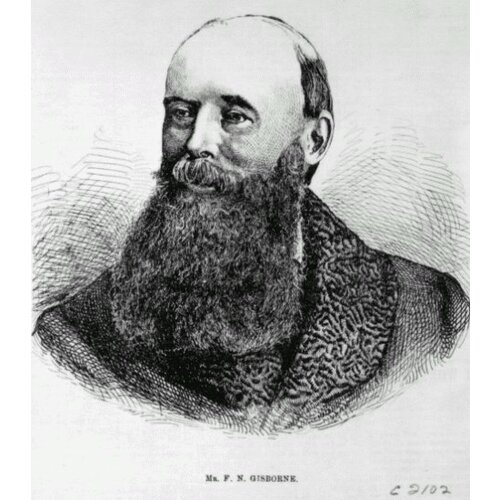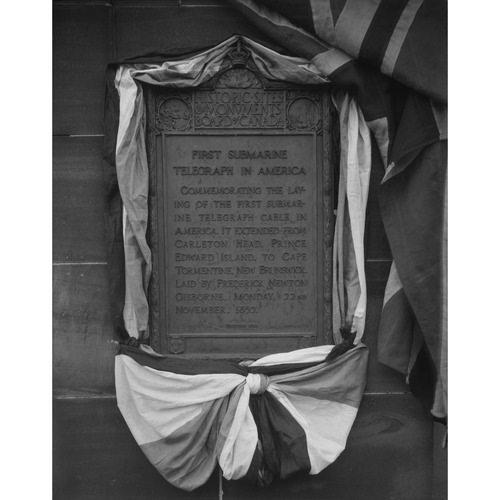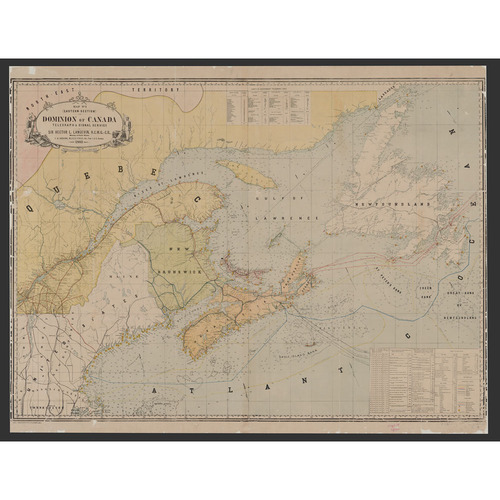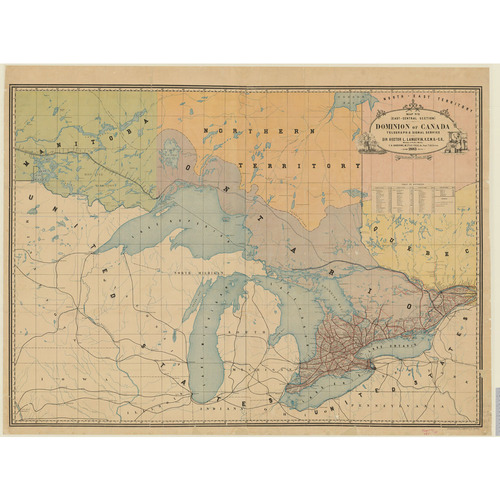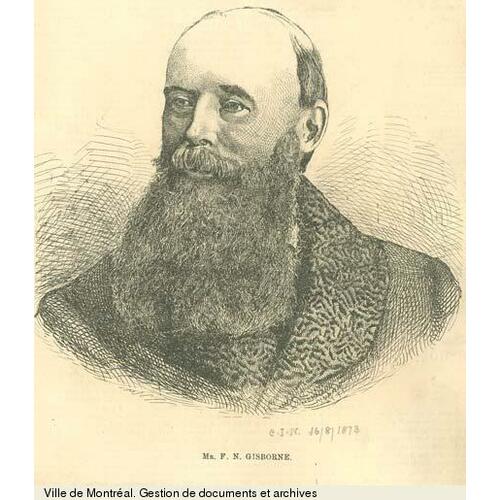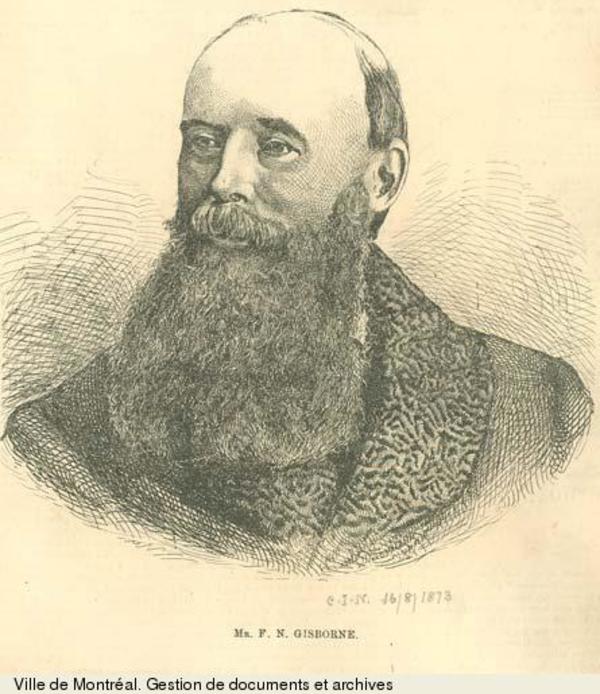
Source: Link
GISBORNE, FREDERIC NEWTON, farmer, telegraph agent, civil servant, engineer, and inventor; b. 8 March 1824 in Broughton, Lancashire, England, son of Hartley P. Gisborne; m. first 31 Oct. 1850 Alida Ellen Starr (d. 1854) in Halifax, and they had two children; m. secondly April 1857 Henrietta Hernaman of Newton Abbot, England, and they had four children; d. 30 Aug. 1892 in Ottawa.
Frederic Newton Gisborne, a member of an established Derbyshire family, was educated by clergymen and special instructors in England. He concentrated on mathematics and electricity and also received instruction in civil engineering, botany, and other scientific subjects. In January 1842, at the age of 17, he left on a three-year world tour that took him to such exotic locales as Pitcairn Island, the Sandwich (Hawaiian) and Society islands, and Central and South America. Upon arriving home in the spring of 1845 he found his family in difficult straits and almost immediately departed again, this time for Canada, with his brother Hartley. They purchased a farm near Saint-Eustache (Que.) but rapidly tired of agricultural life and left in May 1847.
By then telegraphy (first demonstrated by Samuel Finley Breese Morse about a decade earlier) was a burgeoning science, and the first overland line, from Washington, D.C., to Baltimore, Md, had been put into commercial operation in 1845. The two brothers were intrigued by the new invention and enrolled in a course in telegraphy offered in Montreal by one of Morse’s pupils. Frederic passed first in every branch of the course and was offered his choice of posts with the Montreal Telegraph Company, which by August 1847 had completed a line from Montreal to Toronto and was building one to Quebec. He chose to open the Quebec office.
While in Quebec, Gisborne made the acquaintance of a number of “leading men,” and in late 1847 he joined them to form the British North American Electric Telegraph Association with the intention of constructing a line between the Maritimes and Canada. He left the Montreal Telegraph Company in November to become superintendent of the new association, and that winter he was sent to visit New Brunswick and Nova Scotia in order to persuade the governments there to become involved in a Halifax–Quebec line. New Brunswick did not favour the plan, preferring instead a Boston–New York connection. Gisborne arrived in Nova Scotia in March, at the moment when a select committee of the legislature was meeting to inquire into and report on the feasibility of supporting the construction of telegraph lines. The government was impressed by Gisborne’s extensive testimony before this committee and agreed to construct a line from Halifax to Amherst if Gisborne would leave the BNAETA to superintend the project. While returning from Nova Scotia, Gisborne, ever ready for adventure, snowshoed over 100 miles from Restigouche (Que.) to the St Lawrence across the Gaspé mountains, dragging all his belongings behind him on a toboggan. In recognition of this Herculean effort, the BNAETA gave him a monetary bonus and an award on his arrival back in Quebec. Despite the exertions of Gisborne and his fellow members, however, by 1849 the BNAETA had succeeded in completing a line only from Quebec to Rivière-du-Loup.
That spring Gisborne left to assume the position of superintendent and chief operator of the Nova Scotia government telegraph lines, then the only lines in the province. He immediately began to experiment with methods of laying telegraph cable underwater. Similar trials by British engineer John Watkins Brett in the 1840s resulted in the laying of an operational cable under the English Channel from Dover to Calais in 1850. That year Gisborne approached Joseph Howe*, the provincial secretary and a member of the commission established to oversee the operations of the province’s telegraph system, with a plan for submarine telegraphic communication between Newfoundland and the North American continent at Halifax. Howe and the other commissioners were interested in Gisborne’s scheme and granted him a leave of absence in late 1850 to travel to St John’s to secure support for the project. While in Newfoundland Gisborne successfully contracted for a land line from St John’s to Harbour Grace and Carbonear. To the astonishment of Howe and the Nova Scotia commissioners, however, Gisborne returned to Halifax with a proposal for not only the Newfoundland–Nova Scotia line but also a transatlantic line connecting Newfoundland and Ireland. Howe thought the transatlantic project impossible and refused to allow Gisborne leave to seek capital for it. In March 1851 the Nova Scotia legislature incorporated the privately owned Nova Scotia Electric Telegraph Company to take over the government lines and build additional connections, and Gisborne left the employ of the government on 1 July when all the publicly owned telegraph assets were sold to the new company. He then took his 15-year-old wife with him to St John’s, where he began the project of constructing a telegraph line across Newfoundland.
Gisborne persuaded the Newfoundland assembly to incorporate the Newfoundland Electric Telegraph Company, with capital of £100, for the purpose of surveying a line from St John’s to Cape Ray, to connect with Cape Breton via carrier pigeons, steamer, and eventually, Gisborne hoped, a submarine cable. By 1 Sept. 1851 the St John’s–Harbour Grace–Carbonear telegraph line was complete, and Gisborne turned in earnest to the St John’s–Cape Ray route survey. It was an incredible ordeal even by Gisborne’s standards. He started from St John’s with six men to traverse more than 300 miles of unexplored and particularly harsh wilderness. His men all deserted him about 100 miles into the journey, at Long Harbour on Fortune Bay, where a nearby lake still bears his name. Four Indians took their place, but one died from the rigours of the expedition within a few days of leaving Long Harbour, two deserted the party shortly after, and the fourth, who survived to the end, suffered broken health for the rest of his life. Gisborne and his companion finally returned to St John’s on 4 December.
Yet only weeks after the Newfoundland survey Gisborne was off to Boston to promote the transatlantic cable project. After his efforts there proved unsuccessful, he went back to Halifax and again laid the scheme before Joseph Howe, who was no more convinced of its feasibility than he had been in 1850. Gisborne proceeded to New York, where businessmen Horace Tebbets and D. B. Holbrook offered some capital. After a few weeks in New York, Gisborne left for London to see Brett, who also made an initial contribution to the project. In the mean time the Nova Scotia Electric Telegraph Company had set exorbitant prices for the use of its lines in any Newfoundland–mainland connection. Gisborne decided on a route through Prince Edward Island and New Brunswick and ordered the cable while he was in England. He returned to St John’s and, catching the spring sitting of the Newfoundland legislature, obtained an act terminating the Newfoundland Electric Telegraph Company and incorporating a new company of the same name with capital from Tebbets, Holbrook, and Brett. He secured exclusive rights to telegraph construction in Newfoundland for 30 years. By November 1852 the submarine cable between Prince Edward Island and New Brunswick had been laid, using machinery and technology largely devised by Gisborne himself. It was the first submarine cable in North America.
The business of raising capital for the great transatlantic project began in earnest in the spring of 1853. Gisborne organized a company in New York with Tebbets and Holbrook, and received an offer from Brett to divide the raising of capital – a total of £750,000 – between the North American company and one Brett would organize in Britain. In April Gisborne incorporated a company in Charlottetown and acquired all cable rights in Prince Edward Island from William Henry Pope*, a prominent lawyer in the colony. Almost immediately he went to Newfoundland to oversee the stringing of the land line from St John’s to Cape Ray, an undertaking that involved hundreds of men and the construction of a road along the route. However, as the line was progressing, Tebbets and Holbrook disagreed over their respective interests in the Newfoundland section and stopped payment on their promised capital. Gisborne was left with debts of $50,000 more than his assets, which included sealing vessels and land. The government of Newfoundland offered to pay the labourers on the project if Gisborne would guarantee a reorganization, but he was stripped of everything he possessed by his creditors. He was released from arrest only by the intervention of some of his highly placed friends in the colonial governments. Brett renewed his offer to raise £375,000 in England if Gisborne could do the same in North America. He requested that Gisborne apply to the Newfoundland government for incorporation of a new company with exclusive rights to the submarine telegraph for 50 years and a public subsidy, in exchange for carrying government messages free.
These exigencies took Gisborne to New York again in January 1854, where he met the wealthy young paper manufacturer Cyrus West Field and some of his companions in capital. Field was bored by the Newfoundland project, but the transatlantic scheme captured his imagination. After consulting with leading authorities such as Morse and Brett, Field gathered a consortium and came to Newfoundland with Gisborne. Brett purchased the assets of the insolvent Newfoundland Electric Telegraph Company, and in April the New York, Newfoundland and London Telegraph Company, with all the privileges Brett had desired and Gisborne as chief engineer, was incorporated by the Newfoundland legislature. Nova Scotia still refused landing rights to the new company, but Gisborne was able to transfer rights in Newfoundland and Prince Edward Island to the company and acquire rights in the state of Maine.
Despite this blazing start Gisborne resigned from the company within a month of its creation, for reasons that remain unclear. He spent the rest of 1854 travelling throughout the United States, while the company wasted great sums trying to complete the land line across Newfoundland under the superintendence of Field’s brother Matthew. An attempt in the following summer to lay the Newfoundland–Cape Breton cable also failed. (Nova Scotia had relented on landing rights when it saw that the cable was about to bypass the province altogether.) Faced with disaster, the company offered Gisborne the chief engineer’s post once again and he accepted. Almost immediately he turned the company’s operations around, laying the Cape Ray–Cape Breton cable in July 1856 and completing the Newfoundland–Nova Scotia line by October.
Later that month Gisborne left for London with C. W. Field and Edward Mortimer Archibald*, the British consul in New York, en route to Bombay (India). Already looking ahead to the next ambitious project, the trio planned to seek privileges and subsidies for a cable from London to Bombay via the Red Sea, with a possible extension to the Far East. However, in London Gisborne discovered that his partners were about to cheat him in the transatlantic cable operations. Filled with disgust, he abandoned the Bombay scheme, the New York, Newfoundland and London Telegraph Company, and the entire telegraphy business. Field went on to raise sufficient capital to construct the transatlantic line, but Gisborne was not a part of the celebrations on 27 July 1866, when Field’s company finally succeeded in landing an operational cable at Heart’s Content, Nfld.
Gisborne remained in England until May 1857, when he returned in triumph to St John’s, receiving a public dinner and a silver statuette in appreciation of his work. He then turned to another interest, the discovery and development of mineral deposits in Newfoundland and the Maritime provinces. He explored the Newfoundland coast, from Cape Ray to the Strait of Belle Isle, raised capital in England, and developed at least two sites for the St John’s United Copper and Lead Mining Company.
In 1861 a severe gunshot wound, suffered while he was exploring on the island, put an end to his adventures and sent him back to England. There he undertook research into telegraph, signal, and navigation equipment and patented a wide variety of inventions. Living near London Bridge, he described himself as an “Engineer and Electrician.” In 1862 he was appointed commissioner for Newfoundland at the International Exhibition in London, and he served as commissioner of mines for the Newfoundland government at the Paris exhibition five years later. In 1865 he also became London agent for mines and minerals of the Nova Scotia government. Gisborne exhibited regularly at the Royal Society and won several medals for his inventions, but he lost many of his British patents in 1867 in a corporate swindle.
Two years later, while on a visit to Nova Scotia to gather information as the province’s agent for mines and minerals, Gisborne became enthusiastic about the potential of the Cape Breton coal deposits. He found a group of English investors willing to put money into these seemingly lucrative mines, and by the end of the year was chief engineer of a company operating on the island. He superintended the development of four collieries, the building of several associated railway branch lines, and the upgrading of port facilities at Sydney and Louisbourg. However, the depression of the 1870s and the subsequent collapse of coal prices wrecked the enterprise after more than $3,000,000 had been invested. Gisborne tried to bail out his own finances by diversifying into gold mining in Nova Scotia, but this project also failed. By 1879, at the age of 55, Gisborne was once again wiped out financially.
At this point the federal government seized the opportunity to acquire Gisborne’s expertise and offered him the new post of superintendent of the dominion telegraph and signal service. This appointment, which Gisborne accepted effective 1 May 1879, ushered in a relatively stable time in his career. His first task was to reorganize the expensive and problem-riddled telegraph system in British Columbia. Gisborne immediately travelled there, and by the end of the year the broken lines had been mended and the system was beginning to produce some regular revenue. In 1882, Gisborne was made a founding fellow of the Royal Society of Canada [see Sir John William Dawson].
In the summer of 1883 Gisborne went to inspect the new network of telegraph lines from Fort Qu’Appelle (Sask.) to Edmonton and Calgary, which replaced an old “pioneer” line built along an abandoned Canadian Pacific Railway route. Setting out with his son Hartley, who was on his way to his new post as district superintendent of government telegraphs at Battleford (Sask.), Gisborne travelled more than 1,000 miles by buckboard to Calgary, viewing the first scattered farms, Indian encampments, and tiny hamlets. He then returned to Ottawa by rail, having spent about three months on the trip. In 1885 he had a taste of adventure once again, when he accompanied the expeditionary force sent to the North-West rebellion [see Sir Frederick Dobson Middleton; Louis Riel*]. Gisborne personally supervised the construction of telegraph lines between Dunmore and Fort Macleod (Alta) and Moose Jaw and Wood Mountain (Sask.). He also began the rebuilding of the deteriorating Edmonton–Calgary line.
Gisborne’s other principal accomplishment while superintendent of the telegraph service was the planning and building of a cable line connecting stations along the Gulf of St Lawrence, to be used for transmitting information on fisheries, weather, and marine disasters as well as the usual messages. He continued to lecture and write newspaper articles on a variety of subjects, and at the time of his death in 1892 he was planning a transpacific cable. A member of the Church of England, he had the reputation of being “broad and liberal in his views.” He died quietly and rather unexpectedly while resting at home after an inspection tour of the gulf cable system, succumbing at last to the physical rigours of his life.
Despite his key role in engineering and promoting the transatlantic and other cables and in discovering and developing the Cape Breton coalfields, Frederic Newton Gisborne died in obscurity. His partners had repeatedly tried to steal his innovations, enterprises, and reputation, and in several cases succeeded. However, “the indomitable Electrician,” as one of his English friends called him, is a landmark figure in the history of science and technology in Canada, as well as a picturesque exemplar of the Victorian scientist-adventurer.
[In addition to the sources cited below, the author would like to acknowledge the assistance of the Burchell family of Nova Scotia and Ontario. g.c.d.j.]
Frederic Newton Gisborne’s publications include A midnight fantasy (Halifax, 1850; copy in Nova Scotia Legislative Library, Halifax); Gisborne versus Kennelly . . . : F. N. Gisborne’s reply to D. J. Kennelly’s statement in defence; with extracts from correspondence, &c., added (Halifax,1877); Dominion of Canada telegraph & signal service (broadside, Montreal, 1883); and Gisborne on inception of electrical science and evolution of telegraphy ([Montreal, 1888]).
NA, MG 23, GIII, 34; MG 29, D61: 3292–94. PANS, MG 100, 146; RG1, 422, 442; RG7, 72, no.1812. Victoria Univ. Library (Toronto), F. N. Gisborne coll. Can., House of Commons, Debates, 1879–92; Parl., Sessional papers, 1880–92 (annual reports of the Dept. of Public Works). City of Ottawa, Assessment Dept., Assessment roll (Ottawa), 1879–91. RSC Trans., 1st ser., 11 (1893), sect.ii: 67–68 (obituary tribute by Sir James Grant). Acadian Recorder, 31 Jan. 1857. British Colonist (Halifax), 2 Nov. 1850. Canadian Illustrated News (Montreal), 16 Aug. 1873. Daily Free Press (Ottawa), 30 Aug. 1892. Globe, 31 Aug. 1892. Ottawa Citizen, 30 Aug. 1892. CPC, 1891. Cyclopædia of Canadian biog. (Rose and Charlesworth), 1: 284–88. The encyclopedia of Canada, ed. W. S. Wallace (6v., Toronto, [1948]). Le Jeune, Dictionnaire. Ottawa directory, 1879–92. J. J. Brown, Ideas in exile: a history of Canadian invention (Toronto and Montreal, 1967). John Quinpool [J. W. Regan], First things in Acadia, “the birthplace of a continent” (Halifax, 1936). D. G. Whidden, Nova Scotia’s telegraphs, landlines and cables (Wolfville, N.S., 1938; copy in National Library of Canada, Ottawa).
Cite This Article
Gwynneth C. D. Jones, “GISBORNE, FREDERIC NEWTON,” in Dictionary of Canadian Biography, vol. 12, University of Toronto/Université Laval, 2003–, accessed December 17, 2025, https://www.biographi.ca/en/bio/gisborne_frederic_newton_12E.html.
The citation above shows the format for footnotes and endnotes according to the Chicago manual of style (16th edition). Information to be used in other citation formats:
| Permalink: | https://www.biographi.ca/en/bio/gisborne_frederic_newton_12E.html |
| Author of Article: | Gwynneth C. D. Jones |
| Title of Article: | GISBORNE, FREDERIC NEWTON |
| Publication Name: | Dictionary of Canadian Biography, vol. 12 |
| Publisher: | University of Toronto/Université Laval |
| Year of publication: | 1990 |
| Year of revision: | 1990 |
| Access Date: | December 17, 2025 |


